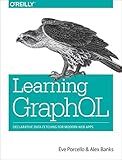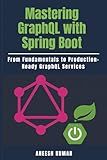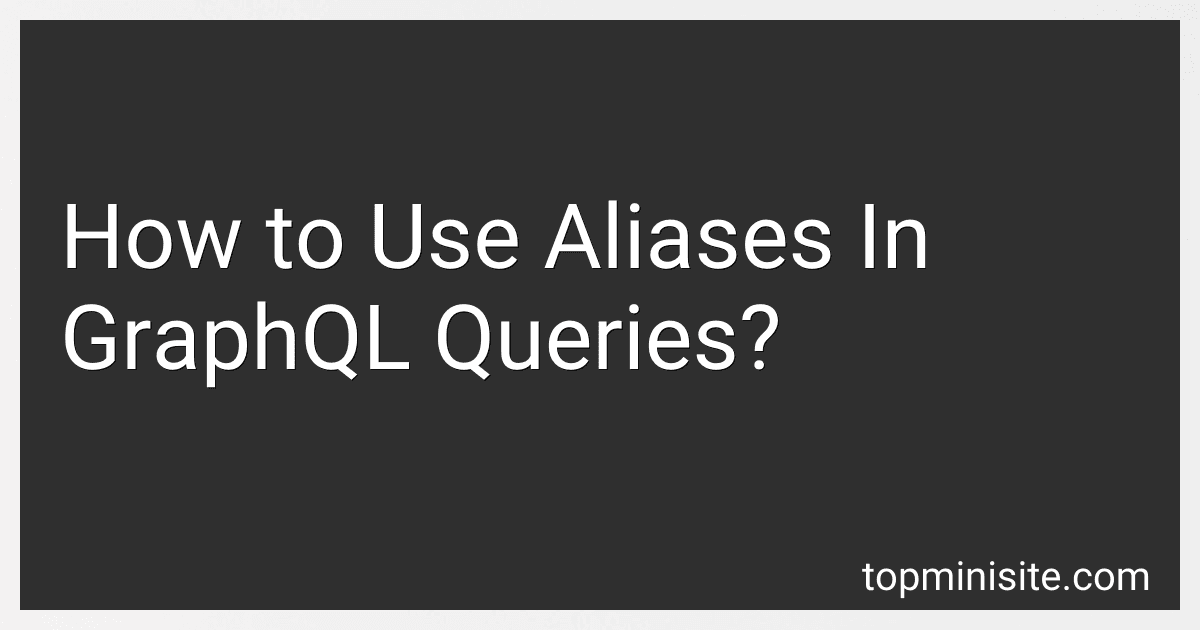Best GraphQL Guides to Buy in December 2025

Black Hat GraphQL: Attacking Next Generation APIs



The Road to GraphQL: Your journey to master pragmatic GraphQL in JavaScript with React.js and Node.js



Learning GraphQL: Declarative Data Fetching for Modern Web Apps



GraphQL Best Practices: Gain hands-on experience with schema design, security, and error handling



Beginning GraphQL with React, NodeJS and Apollo



Mastering GraphQL with Spring Boot: From Fundamentals to Production-Ready GraphQL Services


Aliases in GraphQL queries allow you to rename the fields returned in the query response. This can be useful when you have multiple fields with the same name or when you want to make your query results more readable.
To use an alias in a GraphQL query, follow these steps:
- Start by writing your query as you normally would, specifying the fields you want to retrieve.
- Identify the fields that you want to alias and enclose them within curly braces {}.
- Assign a new name to the field by placing the desired alias followed by a colon : before the original field name.
- Repeat this process for each field that requires an alias.
- Send the modified query to the GraphQL server and receive the response.
Here's an example to illustrate the process. Let's assume we have a GraphQL schema for a blog with a Post type that has a title and an author:
query { post { title author } }
Now, suppose we want to alias the title field as postTitle and the author field as postAuthor. We can modify the query like this:
query { post { postTitle: title postAuthor: author } }
By providing aliases, the response will include the aliased names:
{ "data": { "post": { "postTitle": "Example Title", "postAuthor": "John Doe" } } }
This allows you to retrieve the necessary data while giving each field a more descriptive name in the response.
Remember that you can use aliases with nested fields as well, enabling you to rename fields at different levels deep within your query.
How to use aliases with directives in a GraphQL query?
To use aliases with directives in a GraphQL query, you can follow these steps:
- Define your query with aliases. Aliases allow you to rename the fields in the response with custom names. For example:
query MyQuery { field1: someField { subField } field2: anotherField { subField } }
In the above example, field1 and field2 are aliases for someField and anotherField respectively.
- Specify the directives on the fields you want to apply them to. Directives are special instructions that can be attached to fields and modify the behavior of the query execution. For example:
query MyQuery { field1: someField @include(if: true) { subField } field2: anotherField @include(if: false) { subField } }
In the above example, the @include directive is used to conditionally include or exclude the subField for field1 based on the if argument. Similarly, the subField for field2 will be excluded as the if argument is set to false.
- Execute the query and handle the response. When the server processes the query, it will return the data with the specified aliases and directives. You can access the response data using the aliased names. For example, if you're using a client library like Apollo Client in JavaScript:
client.query({ query: gql` /* your query definition goes here */ `, }).then(response => { const { field1, field2 } = response.data; // Access the response data using the aliased names });
By using aliases with directives in a GraphQL query, you can control the shape of the response data and apply conditional logic based on the directives.
What is the significance of using aliases with mutations in GraphQL?
Using aliases with mutations in GraphQL allows you to make multiple mutations within a single request. This has several significances:
- Batch mutations: With aliases, you can bundle multiple mutations in a single request. It reduces the number of network requests required, leading to improved performance and reduced latency. Instead of sending multiple separate requests, you can send a single request containing multiple mutations and receive all the responses collectively.
- Atomicity: Mutations with aliases are executed atomically, ensuring that either all the mutations succeed or none of them do. If one of the mutations fails, the changes made by the previous mutations are rolled back, maintaining data integrity. This ensures transaction-like behavior and prevents partial updates.
- Reduced network overhead: By using aliases, you can avoid making multiple requests to the server, which reduces the network traffic and overhead. The consolidated request is more efficient in terms of bandwidth usage and reduces the load on both the client and server.
- Complex data dependencies: Aliases allow you to specify dependencies between mutations. By assigning different aliases to each mutation, you can reference the results of previous mutations in subsequent mutations. This enables you to perform complex operations based on the intermediate results of mutations.
Overall, using aliases with mutations in GraphQL improves performance, reduces network traffic, ensures atomicity, and allows complex data dependencies, enhancing the flexibility and efficiency of the GraphQL API.
How to assign a different name to an aliased field in a GraphQL query?
In GraphQL, you can assign a different name to an aliased field in a query. This allows you to retrieve the data you need with a different name than the original field name.
Here's an example of how to assign a different name to an aliased field in a GraphQL query:
query { user(id: 123) { firstName: name email } }
In this example, we are querying the user field and specifying an alias for the name field as firstName. The email field remains unchanged.
The response to this query would look something like:
{ "data": { "user": { "firstName": "John", "email": "john@example.com" } } }
As you can see, the firstName field has been aliased to name and returned with the value "John", while the email field remains the same.
By using aliases, you can control the resulting field name in the response, making it easier to match with your application's data model or structure.
